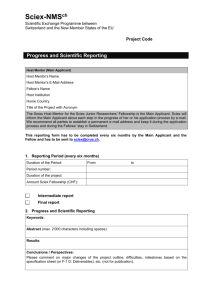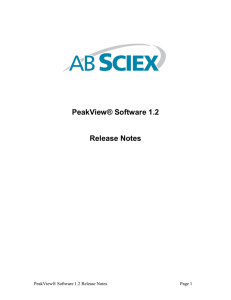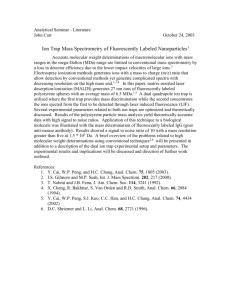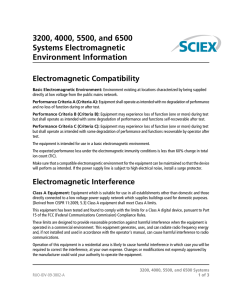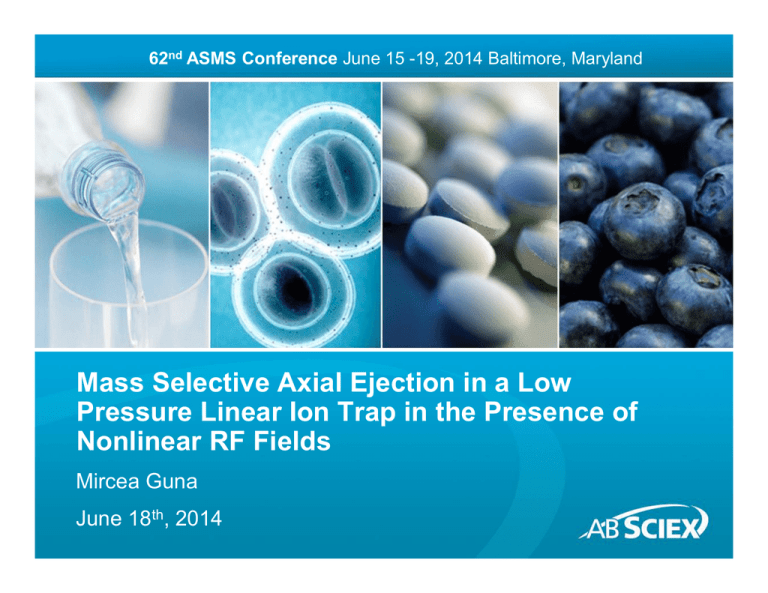
62nd ASMS Conference June 15 -19, 2014 Baltimore, Maryland
Mass Selective Axial Ejection in a Low
Pressure Linear Ion Trap in the Presence of
Nonlinear RF Fields
Mircea Guna
June 18th, 2014
QTRAP® Technology. Mass Selective Axial Ejection
Linear Ion Trap on a Triple Quad backbone
The axial ejection linear ion trap
- operates in the low 10–5 Torr presurre regime
- ions emerge from the end of the device.
QqQlinear ion trap geometry combines all of the features of a
conventional triple quadrupole mass spectrometer and a
linear ion trap.
Hager JW, Le Blanc JCY (2003) Rapid Commun Mass Spectrom 17:1056–1064
2
© 2014 AB SCIEX
QTRAP® 6500 system à high sensitivity
QqQ/LIT
Enhanced Product Ion Scan (EPI) Diagram
– precursor ion selection in Q1
– beam type fragmentation in the collision cell Q2
– trap products and the un-fragmented precursor
ions in Q3
– analytical scan - Linear Ion Trap mass scan
QTRAP® 6500/5500 System Ion Path
Q3 LIT
Curtain
Plate
Orifice
Pulse Gas
Valve
Q2
MS/MS
Q0
QJet® 2
3
© 2014 AB SCIEX
Q1-RF/DC filter
Multi Target Screening
- A predefined list of compounds is looked for in a Multiple Reaction
Monitoring (MRM) experiment.
- Once a compound is detected above a defined threshold an EPI
scan is collected and compared against a library.
- Dynamic exclusion of compounds where MS/MS spectra are already
acquired allows the data collection of co-eluting compounds.
Required Mass accuracy:
0.1 Da or better.
Experimental Sequence of a Multi Target Screening
(MTS) approach
4
© 2014 AB SCIEX
Ion Trap Mass Spectral Quality and Space Charge
Space charge causes loss of
– mass assignment
– peak shape
– relative intensities
More sensitive MS/MS systems will exacerbate this issue as we strive to
lower our overall limits of detection.
5
© 2014 AB SCIEX
Effects of Space Charge – QTRAP ® 6500.
DFT turned OFF.
X 30 ions
∆ m > 0.4 Da
Zoom
Zoom
X 30 ions
6
© 2014 AB SCIEX
Methods to Mitigate Space Charge Effects in RF Ion Traps
Goal is to maintain spectral fidelity with increasing ion population.
Can use:
- ‘dynamic fill time‘ (DFT) or Automated Gain Control, but increased cycle times
thus loss of chromatographic resolution
- Tandem ions traps, amenable for large mass range scans (Guna and Londry,
Anal. Chem. 2011, 83, 6363-6367)
- Internal Calibration (Remes and Schwartz ASMS 2012 MP30-706)
- Nonlinear Fields
7
© 2014 AB SCIEX
Nonlinear RF Fields in Ion Traps.
- 3D Ion Traps – ejection slit, stretched or asymmetric
configurations (Stafford, Syka, Franzen, Wang, Cooks)
- Radial Ejection LIT - slit, stretched, non-hyperbolic rods
(rectilinear), asymmetric applied RF fields (Schwartz,
Cooks, Welsh)
- Axial Ejection LIT – round rods, asymmetric rods
(Hager, Douglas)
- Toroidal IT – curvature (Austin, Lammert)
Practical Aspects of Ion Trap Mass Spectrometry Series. CRC Press.
Editors Raymond E. March, John Francis James Todd
8
© 2014 AB SCIEX
Mass Selective Axial Ejection. QTRAP® Technology
- mass-selective axial ejection (MSAE) of ions takes advantage of the RF
fringing fields, at the end of the linear quadrupole, to convert radial ion
excitation into axial ejection.
- the higher the radial amplitude the stronger the axial force experienced
by the ions.
Dehmelt approx.:
E z, quad
RF
x = X +δx
∂f m Ω 2 2
qx X 2 + Y 2
=
∂z 8e
(
)
ion radial amplitude
fringing field
9
© 2014 AB SCIEX
Londry and Hager, JASMS, 2003,14, 1130-1147
Nonlinear High Capacity Linear Ion Trap (NHCT)
Research Prototype.
Schematic of the Electrical/Mechanical set-up of the NHCT.
The RF on the T-electrodes was generated by a signal generator,
phase-locked to the main RF and amplified by an amplifier.
10
© 2014 AB SCIEX
Nonlinear High Capacity Ion Trap. RF fields.
RF Potential due to the Auxiliary Electrodes
-6
500
450
400
350
300
250
200
150
100
50
0
-4
-2 -50 0
2
4
Distance from the quadrupole axis [mm]
y = 0.0002x6 + 1E-06x5 - 0.0117x4 - 2E-05x3 + 0.0104x2 - 5E-05x + 2.3137
2.5
2
0V
50 Vp-p
1.5
Potential [V]
Potential [V]
RF Voltage in Excitation Plane. Main RF voltage
884 Vp-p
Z 2.4mm from the Exit Lens
1
0.5
0
6
-6
-4
-2
0
-0.5
2
Distance from the quadrupole axis [mm]
11
© 2014 AB SCIEX
4
6
RF Electric Field. z 2.4mm.
Electric Field due to Auxiliary Electrodes
y = 6E-08x6 - 0.0003x5 - 3E-06x4 + 0.0096x3 + 3E-05x2 - 0.0047x - 3E-06
0.4
50
0.3
40
30
Electric Field [V/mm]
20
10
0 Vp-p
0
-6
-4
-2
-10
0
2
-20
-30
-40
-50
Distance from the quadrupole axis [mm]
12
© 2014 AB SCIEX
4
6
50 V p-p
Electric Field [V/mm]
0.2
-6
0.1
0
-4
-2
0
2
-0.1
-0.2
-0.3
-0.4
Distance from the quadrupole axis [mm]
4
6
Ion Motion Frequency vs. Auxiliary RF
Experimental Measured m/z
195.6
345000
195.4
343000
f [Hz]
0 Vp-p
339000
337000
335000
333000
0
1
2
Amplitude [mm]
13
© 2014 AB SCIEX
3
mz/ [Da]
195.2
341000
195
25 Vp-p
194.8
50 Vp-p
194.6
75 V p-p
194.4
0
20
40
60
Auxiliary RF [Vp-p]
80
100
Effects of Space Charge – QTRAP ® 6500.
DFT turned OFF.
X 30 ions
∆ m > 0.4 Da
Zoom
Zoom
X 30 ions
14
© 2014 AB SCIEX
Effects of Space Charge – NHCT. DFT turned OFF.
X 30 ions
∆ m < 0.1 Da
Zoom
Zoom
X 30 ions
15
© 2014 AB SCIEX
QTRAP ® 6500 vs NHCT
QTrap ® 6500
NHCT
100
100
90
90
80
80
70
70
60
60
50
50
40
40
30
30
20
20
10
10
0
0
361
363
365
367
369
371
361
363
365
367
369
- x30 Ions
16
© 2014 AB SCIEX
371
Mass Accuracy is retained for large populations of ions.
NHCT
7k ions
70k ions
700k ions
17
© 2014 AB SCIEX
Intra-Scan Dynamic Range. NHCT
7k ions
70k ions
700k ions
18
© 2014 AB SCIEX
Mass Shift vs Total Number of ions in the NHCT
Mass Shift of the 213Da peak vs. Total Number of Ions present in the trap. RF
Voltage on the T electrodes was 60 Vp-p
0.25
0.2
Mass Shift [DA]
0.15
0.1
60 V
0.05
0
0
-0.05
19
© 2014 AB SCIEX
250000
500000
750000
1000000
Total Number of Ions [counts]
1250000
1500000
Influence of the Auxiliary Electrodes RF voltage on Mass
Shift. Scan Rate 10 kDa/s. 4cm long NHCT.
Mass Shift of the 213Da peak vs. Total Number of Ions present in the trap and
RF Voltage on the T electrodes
0.25
0.2
Mass Shift [DA]
0.15
0V
20 V
0.1
40 V
60 V
0.05
QTRAP 6500
0
0
-0.05
20
© 2014 AB SCIEX
250000
500000
750000
1000000
Total Number of Ions [counts]
1250000
1500000
Searching for impurities. Fendiline & Flusilazol mixture
F
F
Fendiline:Flusilazol 100,000:1
316.206 Th:316.1076 Th
F
F
F
Zoom
F
F
F
21
© 2014 AB SCIEX
F
SUMMARY
Higher order fields increase the space charge immunity of
the trap by at least a factor of x10.
Applicable to all of the applications that use trap scans
(e.g., MIDAS Workflows)
Improvements, at large ion populations, in:
– Mass assignment and Resolution
– Spectral Quality
– Intra-scan dynamic range
22
© 2014 AB SCIEX
Acknowledgements
23
Designers
Scientists
Pablo Dominguez
Jim Hager
John Vandermey
Larry Campbell
Matthew Romaschin
Frank Londry
© 2014 AB SCIEX
Trademarks/Licensing
For Research Use Only. Not for use in diagnostic procedures.
© 2014 AB SCIEX. The trademarks mentioned herein are
the property of AB Sciex Pte. Ltd. or their respective owners.
AB SCIEX™ is being used under license. All rights reserved.
Information subject to change without notice.
24
© 2014 AB SCIEX
Questions and Answers

